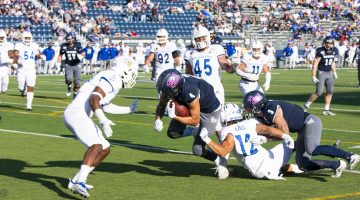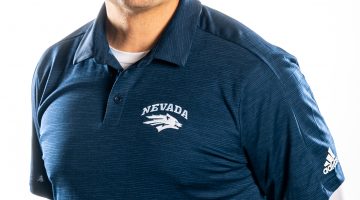By Jack Rieger
Sports journalists are naturally optimistic; it’s in their nature to root for the teams they cover. As a team continues to succeed, more people become interested in their story, and more readers gravitate to their column.
I’ve sold Sagebrush readers for the past six weeks on Nevada’s potential to be a premium football team, but now I’m ready to be realistic. Nevada’s football team isn’t very good.
Statistically, Nevada is an average college football team in a poor football conference. Since Brian Polian’s hiring in January of 2013, Nevada has gone 14-18 overall, which includes Saturday’s 28-21 loss to previously winless Wyoming. In that same span of time, Nevada is ranked sixth in the Mountain West Conference in points allowed and seventh in points scored out of 12 teams. They haven’t won a bowl game since 2011, when Nevada beat Boston College in the Kraft Fight Hunger Bowl.
Now let’s address a more complicated idea: What are realistic expectations for Nevada football?
The West Coast is a competitive area of the country to recruit high school football players. Stanford, California, USC, UCLA, Oregon, Arizona, Arizona State and Utah all have premier college football programs. Try convincing an 18-year-old kid to come to “the biggest little city in the world” instead of Venice Beach; it’s not realistic.
Premier West Coast programs like USC also have massive recruiting budgets to finance recruiting trips. According to a study done by USA Today, the average recruiting budget among Football Bowl Series teams was $700,000 in 2013. Nevada’s 2013 recruiting budget was only $208,000, ranking sixth in their conference and nearly 20 percent below the MWC average. For comparison, the University of Oregon’s 2015 recruiting budget is $1.15 million.
Although a hefty budget facilitates recruiting and helps produce a winning program, big money doesn’t necessarily guarantee big success. From 2009 to 2013, the University of Illinois spent $791,972 on recruiting annually but only had a winning record once during that span.
Every sports league in the United States, both collegiate and professional, has financial imbalances. The Los Angeles Dodgers have the largest payroll in baseball, yet haven’t won a World Series since 1988. Money alone can’t buy wins. An important element of a program’s success is how efficiently they’re able to convert money into wins, which is something Nevada has done well. Since 2009, Nevada has spent $15,451 recruiting dollars per victory, sixth best in the country. Boise State also proved to be an economical program, spending $11,967 recruiting dollars per win.
Given their geographical disadvantages and lack of financial support, it’s appropriate Nevada football loses regularly to teams like Wyoming and UNLV, but local fans don’t think that way. Remember — fan is short for fanatic, and fans tend to let emotion and pride distort their judgment.
Has Nevada had some success in the history of their program? Absolutely. Just five years ago they finished the season ranked 11th in the country thanks to the play of Colin Kaepernick, an overlooked high school recruit who accepted the only scholarship offered to him. But those seasons are the outliers; they aren’t sustainable. Nevada has been in just 12 bowl games in the last 23 years, and they’ve only won three of those games. With Saturday’s loss to Wyoming, Nevada falls to 3-4 on the season and 1-2 in conference.
This is who they are.
Jack Rieger can be reached at jrieger@sagebrush.unr.edu and on twitter @JackRieger













